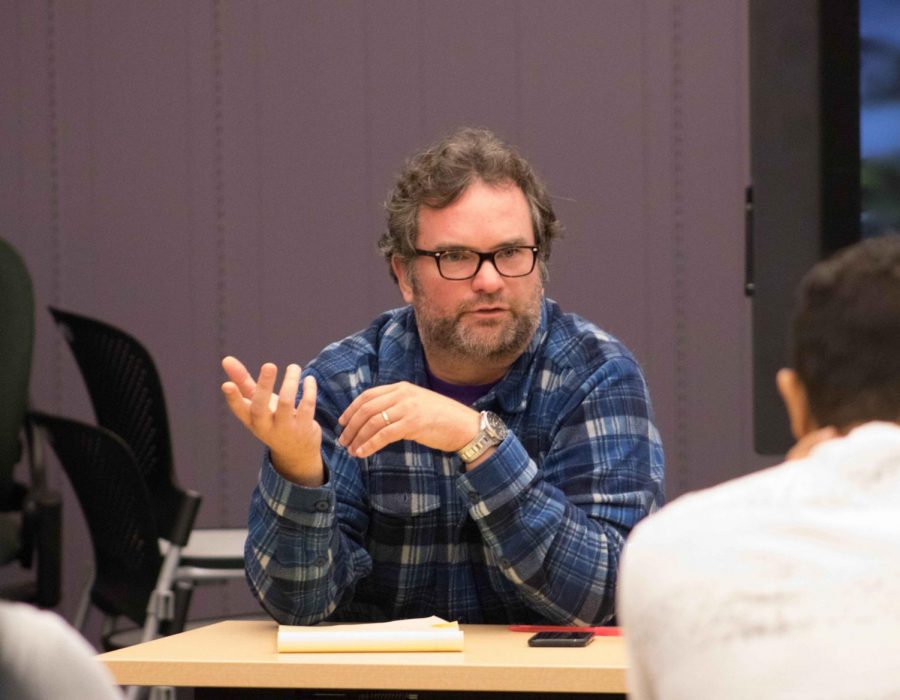Prof talks buddies and boogeyman
Professor Evan Renfro talks media and global politics in a #PanthersVote lecture in Rod Library on Oct. 1.
Oct 4, 2018
Evan Renfro, professor of Political Science, gave a lecture titled “Buddies and Boogeymen: U.S. Foreign Policy as Domestic Politics” on Oct. 1 at 4 p.m. in Rod Library.
Renfro’s lecture was the final of five lectures in the #PanthersVote series designed to engage, inform and encourage voter turnout in the run-up to the midterm elections in November. The lecture series was hosted by the American Democracy Project.
The lecture began with Renfro discussing the origin of the idea of “boogeymen.”
He explained that the concept was developed by professors Noam Chomsky and Edward Herman, who created the Propaganda Model in the 1980’s. This model was an attempt to understand how mass corporate media shapes narratives and perceptions about the world.
To demonstrate how syntax informs narratives, Renfro asked, “if I told you there was a militant that was captured, and there was a soldier that was kidnapped, which one would you feel sorry for?”
The use of the words “soldier” and “militant” is just one way media can shape narratives. This affects how and what decisions are made by people in power, Renfro explained.
Renfro made clear that the Propaganda Model cannot be applied to all media outlets, only those which are privately owned. This is because stories in private media must pass through a number of “filters,” Renfro said.
He listed five filters which help to shape the narrative of a news story: flack, concentration of ownership, reliance on advertising, reliance on experts and elites, and the boogeyman.
Flack is “highly orchestrated criticism,” according to Renfro. It prevents reporters from criticizing those in power and keeps investigative journalism within the boundaries set either by those in power or the owners.
Renfro noted his former professor published an editorial in the Los Angeles Times which criticized Israel for supplying small arms to a Central American country, comparing it to “exporting the Holocaust to Central America.”
She later stepped down from the paper.
He then spoke about about the concentration of ownership.
A problem of concentration is that “you may think you are getting many perspectives when, in reality, those perspectives are in the hands of just a few companies,” Renfro argued.
The notion that there are many different newspapers and websites one can choose from is, according to Renfro, “a myth, a mirage.” He explained that The New York Times, Washington Post, Fox News Network, and the Wall Street Journal are all owned by a small number of private individuals and families.
Another filter leading to news distortion is private publications’ reliance on advertising revenue.
Renfro said this is a problem because “you don’t bite the hand that feeds you.” As an example, he argued that the New York Times would not run an investigative piece on blood diamonds in the Congo because that would upset one of their biggest advertisers, Tiffany’s.
According to Renfro, the reliance on experts in producing news stories creates a biased perspective and fails to capture a diverse set of viewpoints.
“You can choose from the Goldman Sachs banker who is an expert [on the aftermath of the 2008 financial crisis], or you can speak to that single mom who is now living out of her car,” lamented Renfro.
The final filter, the boogeyman, is “that entity which we blame all of our problems,” Renfro explained.
According to Dr. Renfro, “the boogeyman serves as an externalized justification for elected policymakers who can say its not our fault, it’s that other person’s fault.”
After discussing the production of media bias, the lecture turned to Donald Trump’s foregin policy. Specifically, how President Trump has transformed the nation’s typical boogeymen, Russia and North Korea, into allies and the nation’s typical allies, such as England and Canada, into the boogeymen.
Renfro discussed four theories that can possibly help explain this phenomenon.
The first theory, Diversionary War Theory, states that “a country’s leader will initiate conflict with a state in order to divert your attention from trouble at home.” This tactic is often used to inflate polling numbers during times of a domestic crisis.
Renfro explained a second theory, the personalization of politics, as “if I personally like you, we’re going to have good relations…but if I personally dislike you we’re going to have problems”
Trump’s affectionate relationship with Vladimir Putin, argued Renfro, is an example pointing to this theory’s credibility.
Another theory put forward by Renfro was one named after the executive himself, The Trump Model.
The Trump Model is as follows: “heated rhetoric, followed by threats, followed by a sit-down meeting, followed by a nice talk, followed by deal-making,” Renfro explained. “It is nothing but New York real estate.”
The one problem with this theory is that foreign policy is not real estate. “There is not a profit margin[…]people are living or dying,” Renfro said.
Nathan Spicer, a junior history major, said the most interesting part of Renfro’s lecture was “his models for explaining the sudden change in perceptions of foreign affairs.”
Sam Plunk, a senior Political Science major, described the Trump Model as “a pretty intuitive description based on Trump’s time in the real estate market.”









